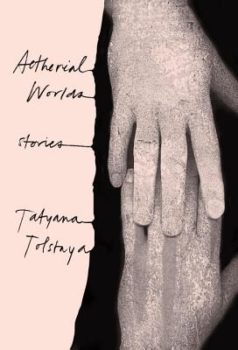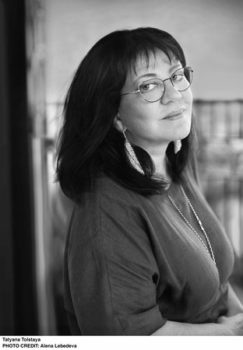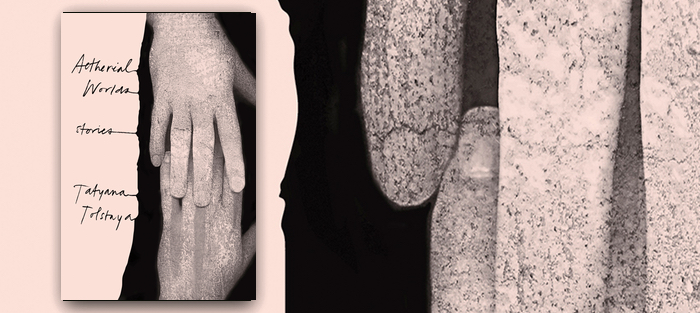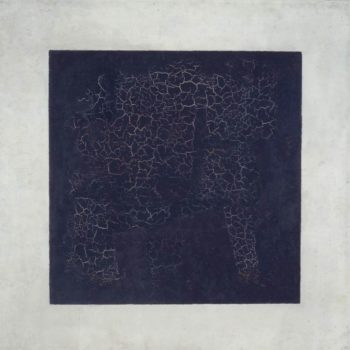In her new book, Aetherial Worlds (Knopf), Tatyana Tolstaya parallels the relationship between truth and fiction as analogous to the relationship of death and life. If something’s indisputably real, then it has no imagination. It possesses zero depiction, since it is what it is and that’s all. A blank sheet of paper—or one that’s completely covered in black ink—can do this. Stories and art are depictions, by definition false, yet good stories and good art convince us otherwise, despite the initial disclaimer that this is a depiction.
Without diving too deeply into philosophy, it’s important to note how our concepts of truth are almost always abstractions. So, it should be no surprise that when art becomes more abstract—and, of course, less representational—it can also become more entrenched in its claim to be truth itself, instead of merely a depiction of truth.
Such a strong claim is the one made by Kazimir Malevich’s 1915 work of art, The Black Square, a painting of the very thing described in its title: nothing more than a black square. This work of art is the subject of “The Square,” one of the pieces in Aetherial Worlds. Appearing decades before Jackson Pollock’s drip paintings, The Black Square is widely regarded as a key point in the break between representational and abstract painting. The painting apparently dominates its surroundings, just as discussion of The Black Square dominates “The Square.”
In “The Square,” Malevich’s Black Square represents, for Tolstaya’s narrator, “gloom, a cellar, a trapdoor to the underworld, eternal darkness.” Other artists and critics offer similar interpretations, such as the artist and critic Alexandre Benois, who said, “Through pride, through arrogance, through trampling of all that is loving and gentle, [The Black Square] will lead all beings to death.”
Perhaps in search of a literary equivalent to Malevich and his Black Square, the narrator of “The Square” describes and then quotes an experience in the life of Leo Tolstoy, a distant relative of Tolstaya’s. According to his diary, quoted at length in “The Square,” Tolstoy experienced “nothingness…zero of form…self-destruction” in 1869, which subsequently led to a “‘spiritual quest.’” The narrator of “The Square” mocks this period of the writer’s life with her own quotation marks, saying that “Tolstoy banished from within himself the life-giving power of art, moving on to primitive parables and cheap moralizing.” However, she also admits that as a result of this spiritual quest, Tolstoy produced a “battle of a genius with the Devil,” and with death. From that battle came Tolstoy’s novella The Death of Ivan Ilyich, which depicts the revelatory end of a rich man’s life, in which death is his salvation.
That’s how Tolstoy dealt with the “‘zero of form’” (triple quotation marks again, since this is originally Malevich’s phrase, according to “The Square”): he depicted a life after death, in keeping with the author’s own religious conversion. “In the end,” Tolstaya writes, “his dying hero is born into death as if into a new life.”
On the other hand, Tolstaya describes Malevich’s Black Square as a “deal with the Devil.” While both works of art move away from “the life-giving power of art” toward death, The Black Square not only breaks from representational art, but also “heralds the end of art, its impossibility, its lack of necessity.” Instead of expanding the world by way of the imagination, The Black Square reduces and shrinks it, like a black hole. It rejects the notion of whatever aesthetic value might be derived from a work of art. Refusing to explore and expand meaning, The Black Square instead cuts it off, reduces art not just to simplicity and abstraction but to oblivion. For Tolstaya, The Black Square demands that art is nothing, void, negation, an abyss. In such a philosophy of art, it is the final, destructive truth.
So, while such an art-historical discussion as “The Square” might appear “misplaced” (as was noted by Lev Grossman in his New York Times review of the collection), a reader can understand Tolstaya’s inclusion of this piece because of its discussion of what’s at risk in the world of art, what art does that’s so important. Namely, it provides a touchstone for meditation on what truth is and isn’t, on what death and life are. After all, for a “post-Square” artist, “Life is death; death is here; death is immediate.” On the other hand:
A “pre-Square” artist studies his craft his entire life, struggling with dead, inert, chaotic matter, trying to breathe life into it; as if fanning a fire, as if praying, he tries to ignite a light within a stone; he stands on his tippy toes, craning his neck in an attempt to peek where the human eye cannot see.
Instead of becoming consumed by a black hole, even a square-shaped, window-like one, Tolstaya’s artist is child-like, attempting to peek “where the human eye cannot see.”
For Tolstaya, “where the human eye cannot see” is the source of art and its life-giving power. She tells about the beginning of her writing career in the first piece that opens the collection, “20/20.” Its first-person narrator is the grandchild of Aleksey Tolstoy—in other words, Tolstaya herself. But it’s not about how Tolstaya genetically inherited her grandfather’s talent for writing. Tolstaya’s career only began after ocular surgery in 1983 in the Soviet Union (”…before they used lasers for the procedure, as they do now, but instead made corneal incisions by hand, with a regular razor blade…”). After three months of healing from this real-life Un Chien Andalou scene, what opened up to her was “a multifaceted underside of so-called reality, a dungeon full of treasure, an aetherial world through the looking glass, a mysterious box with passcodes to all enigmas, an address book with the exact coordinates of those who never existed.” It’s these aetherial worlds referred to in the title, these never-existing possibilities that Tolstaya explores through her writing. Texts, stories, are the essences that construct our lives. Whether consciously or unconsciously, whether intentionally fabricating or telling our version of the truth, we’re creating, with language, a narrative.
 Even “authentic” nonfictional texts can be untruth, as Tolstaya explains in “Judith with the Sword”: “There were whole decades when letters lied; you couldn’t write down anything truthful. People even lied in their personal diaries, fearing searches and arrests, and so, of course, lying in one’s letters was natural.” Letters and diaries themselves can be fiction, if fiction’s what’s needed to toe the Party line. The narrator here has an idea to compile a book of letters, about which she writes: “And how simultaneously wonderful and disquieting it is to read other people’s letters. It’s like peering into a stranger’s window: you feel awkward, you feel curious, it’s better than the movies. Inside there is somebody else’s singular, sui generis life.” This view into another’s life reminds a reader of the “underside of reality” in “20/20.” Such worlds exist only in the words on the page.
Even “authentic” nonfictional texts can be untruth, as Tolstaya explains in “Judith with the Sword”: “There were whole decades when letters lied; you couldn’t write down anything truthful. People even lied in their personal diaries, fearing searches and arrests, and so, of course, lying in one’s letters was natural.” Letters and diaries themselves can be fiction, if fiction’s what’s needed to toe the Party line. The narrator here has an idea to compile a book of letters, about which she writes: “And how simultaneously wonderful and disquieting it is to read other people’s letters. It’s like peering into a stranger’s window: you feel awkward, you feel curious, it’s better than the movies. Inside there is somebody else’s singular, sui generis life.” This view into another’s life reminds a reader of the “underside of reality” in “20/20.” Such worlds exist only in the words on the page.
However, even though many of these letters, and even diaries, might not be true, there’s still value to them, still meaning, still something coming from a human being. Doesn’t a lie still have more meaning than a black hole? Than negation? How would the world—the only one we really have—be if we’d exhausted the aetherial worlds of art and writing?
Given the current situation of our society, such a question is apropos. Tolstaya takes it as a premise in “Without,” describing the world without Italy, without Rome, presumably without the Stanze di Raffaello in the Vatican Museums. Who would (and why) ask whether those frescoes are fiction or not? Where the “life-giving power” comes from is the meditation art fosters, something not at all simple, something made up of the concreteness that comes out of experience, formed so well by Tolstaya’s language.
Because for a book titled Aetherial Worlds, Tolstaya’s collection is everything but abstract, the negation of the negation that is The Black Square. In the title story, aetherial worlds rise from the quotidian landscape of rural New Jersey. In “Smoke and Shadows,” a story within a story, the narrator undergoes a fugue while she sits in the banal setting of a cafeteria at an American university. This is revealed to the reader just as the story is beginning to become very concrete indeed—when the narrator has murdered her lover’s wife and then the lover himself. Tolstaya even includes a recipe in her collection. Published originally in The New Yorker, “Aspic” is a description of the Russian delicacy kholodets, a sort of pork jelly. The story as recipe, or recipe as story, becomes intoxicated with its own description of the dish, the cook drunk with her own lyrical craft:
Now it’s boiling, raging. Now the surface is coated with gray, dirty ripples: all that’s bad, all that’s weighty, all that’s fearful, all that suffered, darted, and tried to break loose, oinked and mooed, couldn’t understand, resisted, and gasped for breath—all of it turns to muck. All the pain and all the death are gone, congealed into repugnant fluffy felt. Finito. Placidity, forgiveness.
Here is a different kind of reduction than The Black Square, a literal one. Simple but essential, this piece of writing feeds people. If aspic inspires such language, why does it matter whether the cook is Tolstaya or a character she created? The narrator doesn’t know why Russians make kholodets. “But, for some reason, it must be done.”
It’s this attention to concrete, terrestrial language that defers the abysmal abstraction of The Black Square. It’s the kind of attention to craft most writers can identify, exemplified in this conversation between the creative writing professor-narrator and one of her students in “Aetherial Worlds”:
“What if you lift it here and pull this way?” I asked carefully, and pointed with my finger.
He looked.
“That could work,” he said after some thought, “but won’t it sag there?” He also indicated.
“Yes…but if you pad right here, la la la, maybe four lines or so, no more, and then trim the beginning?” I couldn’t, I simply couldn’t believe that this was happening.
Later, he even rejects one of her suggestions to remove some language: “No, I need that. I’ll move it into the shadows. And, and…and I’ll add a J, it’s nice and graphite.” When a work of art is already presented as fictional, as made up, the way to trick its viewer, its reader, into finding truth is to pay attention to concrete details, down to the granular level of discussing the sounds of individual letters. Abstraction isn’t what’s important here. It’s easy to say that The Black Square is true, The School of Athens made up. But after that, what’s left to say about the former?
Tolstaya’s writings provide no absolutes, just a window between worlds. In “Invisible Maiden,” there is a whole section about such a window. It’s here Tolstaya withholds claims and knowledge and simply paints a beautiful and sad picture:
If you look through the blue glass long enough, someone will die. Not completely, not hopelessly—after all, death doesn’t really exist—but they will no longer walk among us. You will no longer be able to touch them, kiss them, to inhale the scent of their hair and neck, to take them by the hand, to ask them a question, to look them in the eye—none of this will be possible any longer. They leave us for that gray, twilit land beyond the blue glass. By bringing my face close to it and looking long enough—through the rustling and the undulation of the garden, the swaying of the branches in the wind, through the melancholy bloom of gray jasmine and the sea of gray lilac—I seem to be able to make out their faces, their hands: they are looking at us and waving, they’ve noticed us. Perhaps there, on the other side, it’s fun for them and bright; perhaps they’re playing ball or simply sailing on airships above our gardens—submerging their arms deep into the warm air and yanking flowers by their long stems, and picking petals one by one to tell fortunes. Why wouldn’t they try to tell fortunes? Perhaps from this side of the blue glass we appear to them gray and wistful, locked away and unattainable—I don’t know. But the blue glass is the window of heartache, and one oughtn’t look through it intently or for long.
Anya Migdal delicately and subtly translates the most important feature of this poignant, winding passage—its rhythm. Windows are for looking, that’s all, and not for too long either. These worlds, aetherial, are nonetheless not to be taken lightly.
This becomes quite literal in the penultimate story, “The Window,” in which a window materializes goods randomly, so long as the receiver of the announced good answers, “Deal!” The main character, Shulgin, accumulates a fortune in this manner, from trivial material items to architecturally impossible rooms attached to his studio apartment. But after the accumulation threatens to ruin his life and he becomes fed up, he responds to the window, “No deal!” The result: “‘Oh! Then it’s my turn!’ happily responded the window.” Now, whenever Shulgin says a noun, a voice says “Deal!” and whatever it is that Shulgin has named leaves this world for the one on the other side of the window. The story ends with him holding back from saying his wife’s name. For Shulgin, speech has become a very risky act indeed.
 The ever-giving window, once refused, becomes the negation, the window that won’t stop taking, reducing us to absolute silence. Does this square-shaped black hole sound familiar? Tolstaya has brought us back to Malevich’s obliviating obstacle, that which ends the idle, as-yet unexpressed meditation of art. She needs to finish with something redemptive. Otherwise, we’ll be stuck on the wrong side of the glass.
The ever-giving window, once refused, becomes the negation, the window that won’t stop taking, reducing us to absolute silence. Does this square-shaped black hole sound familiar? Tolstaya has brought us back to Malevich’s obliviating obstacle, that which ends the idle, as-yet unexpressed meditation of art. She needs to finish with something redemptive. Otherwise, we’ll be stuck on the wrong side of the glass.
This redemption happens during the final piece in the collection, dedicated to her father. Presumably, it’s another story from Tolstaya’s personal life, an exploration of a place from which her father once sent her a postcard. Now he’s dead. The postcard from Ravenna, Italy, is another window—this time into the world of her father’s past. Written on the blank side is a note ending with the words “See the reverse,” the title of this piece. “See the Reverse” shows this other side of the world, illuminated through the thoughtful lens of art, a way for a daughter to feel love for her father, who’s now gone. Only the artifacts he left remain charged with his presence, his language. And, maybe, this place, Ravenna, which he called “beautiful,” still holds his presence.
It’s clear the narrator is trying to find a way into this other world, one where her father is still alive and they can see the beauty of Ravenna together. But Ravenna is still in this world, the one in which her father is dead. After describing the landscape, one three-word sentence reads in sum: “My father’s grave.” On the brink of disappointment, the narrator enters a church, one famous for its mosaics. Inside there are more tourists than worshipers. She notices an old man in a wheelchair, who puts money in a box to switch on the illumination of the mosaics. The man’s face is lowered. A guide is describing the mosaics to him. Of this blind man, Tolstaya writes:
For we are just as blind—no, a thousand times blinder—as that old man in the wheelchair. The truth is whispered to us but we cover our ears, we are shown the truth but we turn away. We lack faith: we are afraid to believe because we are scared of being fooled. We are certain that we are in a crypt. We know for sure that there is nothing in the darkness. There couldn’t be anything in the darkness.
This is the condition of The Black Square, hopeless oblivion. It’s abstraction from the surrounding concrete reality. But this is a choice. The easiest thing to know is that there is nothing to know.
Tolstaya doesn’t end the story there, however. She follows the old man, as if to uncover more about his character, his story. She witnesses him at a cafe. As with “Aspic,” we have to feed ourselves. Like him, we’re “fumbling in the dark for that invisible and magnificent sustenance.” Whether or not this moment really happened, the detail of a blind man enjoying pizza (think of Raymond Carver’s “Cathedral”) is a concrete truth, one that can give hope, even if it’s just a story.







